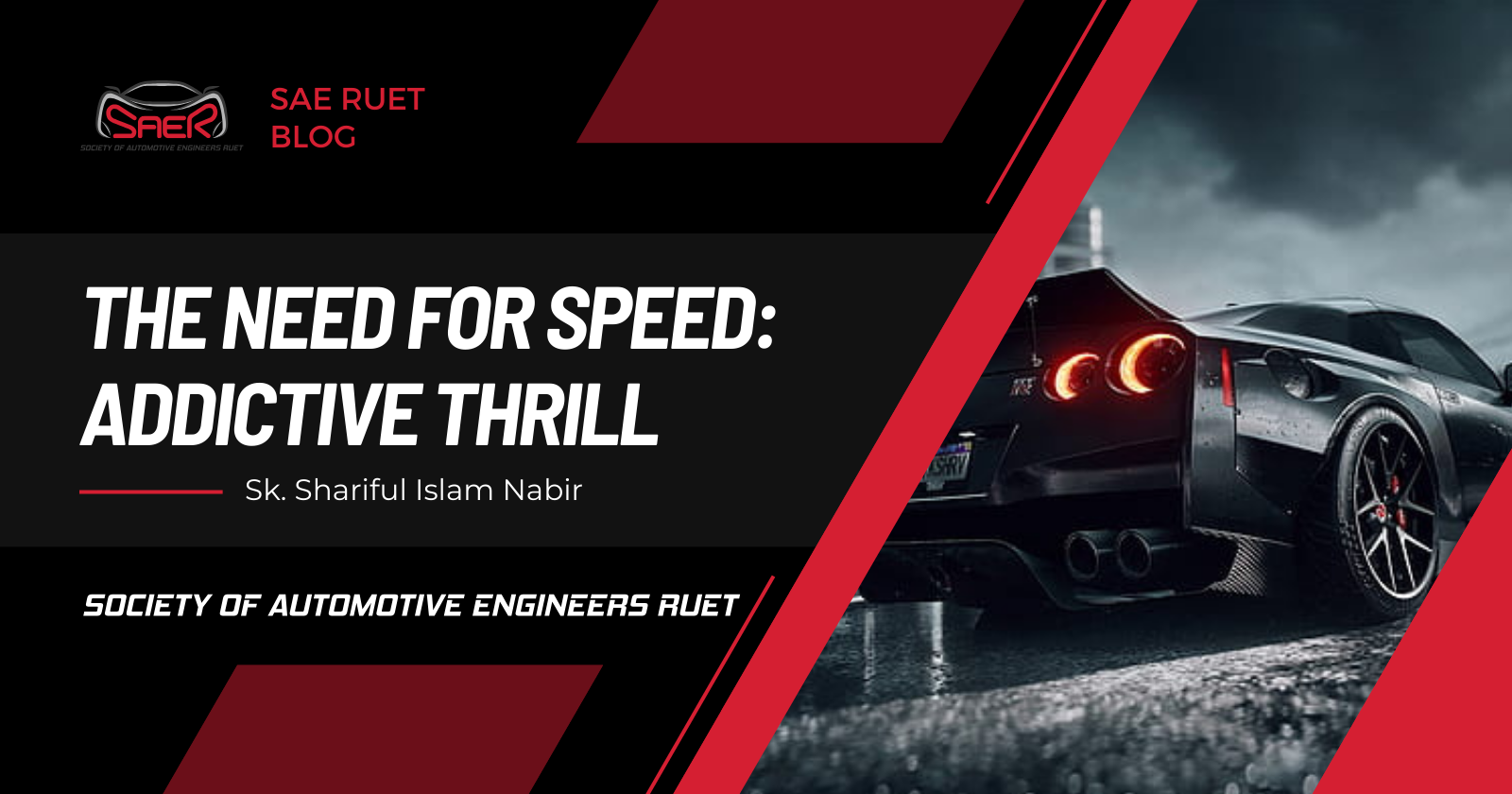The Need for Speed: Addictive Thrill of Driving Fast
 Society of Automotive Engineers RUET
Society of Automotive Engineers RUET
Have you ever heard of the term ‘Need for speed’? No, I am not referring to the famous movie or the video game franchise here. It actually refers to the people addicted to driving their cars fast. They are the so-called adrenaline junkies who enjoy such intense-but-not-so-safe act which creates an adrenaline rush in their brains. So, what exactly is adrenaline? Why do we like it? And how does driving fast release it?
Adrenaline, also called epinephrine, is a hormone. You can think of hormones as a type of chemical messenger flowing through your bloodstream and causing various cells it encounters to act differently than they normally would. Now on top of each of your kidneys, are your adrenal glands. During stressful, exciting or dangerous situations these glands release various hormones like adrenaline into your bloodstream. This is known as a ‘fight-or-flight response’. Because you are in danger, your body prepares to fight or take flight. The adrenaline released during this fight or flight response causes a noticeable boost in your strength and reaction speeds (remember how Bruce turns into Hulk under intense stress or anger in the movies? Unfortunately, you do not become Hulk by this adrenaline rush though). Your body does this by dilating air passages to increase the oxygen intake. Then when adrenaline comes in contact with your cardiac pacemaker cells, your heart rate increases sending that extra oxygen to your brain and all the other tissues in your body like your muscles. Boom! The body's sensitivity to pain also decreases because of adrenaline. Which is why you can continue running from or fighting danger even when you are injured. Most people really like this feeling even if it is triggered by dangerous situations.

But it is not only the adrenaline that is so addictive. There is also a different chemical coursing through our veins during an adrenaline rush, it is another hormone called dopamine. “Dopamine is a neurotransmitter that has a variety of different roles in our central nervous system,” says addiction expert Dr. Robert Heirene, a postdoctoral researcher at the University of Sydney. “Dopamine is the chemical messenger that lets us know when something feels good or pleasurable. One of its main functions is for motor control and motor movement but most people know it as a sort of pleasure or pleasure neurotransmitter because of its starring role in our brain’s reward systems.” To put it simply, our brain releases dopamine as a reward for when we do something it likes. Eat some delicious food or win 20k bucks on a lottery, your brain will release dopamine. Likewise, driving fast releases extreme amount of dopamine; consequently, the newly surge of these feel-good hormones gives us pleasure and we tend to drive faster than we normally would.
Now that we know about the chemical processes in the brain, we need to understand the other key element of this thrill-seeking behavior: the safety net. The fight-or-flight response is designed to help you evade serious danger, and possible death by transforming your natural abilities into near-superhuman abilities. As humans, we generally avoid activities that will put us in real harm’s way such as diving off a cliff with no parachute. Sure, that free fall may be exciting for the first few seconds but certainly the end result of it would not be so pleasurable. Our brains in general want to avoid these situations because it is almost a guaranteed way to say, ‘Game Over’! But despite knowing all the dangers, why do we still do such daredevil act? Yes. The safety net. We can see there is one thing common about driving fast, skydiving, extreme sports, and even horror movies; they are all designed to give you the feeling of imminent danger but wrap you in a safety net of control. A car may rush you along at 200 MPH, but you are in control of the wheel, you are wearing a helmet, and you are wrapped in a safety cage. Likewise, skydiving has a parachute and a backup parachute, rollercoasters have safety restraints. It all has a safety net! So, you feel safe enough to engage in such potentially dangerous activity. You get all the chemicals flowing, with none of the rewards of, you know, death.
But so often, this is not the case. In Bangladesh, excessive speed is one of the major causes of road accidents, killing a significant number of people every year, and data says 60% of pedestrians fell prey to over-speeding in 2022 alone. According to the Road Safety Foundation, an organization working on prevention of the road accidents, 1,627 pedestrians were killed in road accidents in 2022. 59.78% of accidents took place due to the reckless speed of vehicles (Tajmim, 2023). In the USA, for more than two decades, speeding has been involved in approximately one-third of all motor vehicle fatalities. In 2021, speeding was a contributing factor in 29% of all traffic fatalities (Speeding | NHTSA, n.d.). The sheer magnitude of the horrors embedded in these numbers should serve as a powerful catalyst for change. It's a call to reevaluate our driving habits, to prioritize safety over speed, and to recognize the profound impact our choices can have on the lives of others. Each statistic reflects a potential mother, father, sibling, or friend, leaving a void that can never be filled.
Cure to over-speeding: Quite simply, speeding is dangerous (Unless you are driving at Germany’s Autobahn) and can increase the risk of crashes and the severity of injury when a crash occurs. Research clarifies that higher speed is related to increased crash and injury risk at both the individual driver level, and at a road section level. Managing speed is therefore an essential aspect of a safe transport system that aims to prevent the worst outcomes i.e. death or serious injury. Lower speeds can also help to reduce the societal and individual costs of crashes, injuries, and the burden of post-crash care. Accordingly, speed management is widely considered an essential pillar of a safe system approach to road safety. The measures include:
Give yourself more time: Give yourself more time to get to your destination.
Check your speedometer: Regularly check your speedometer to ensure you're not speeding.
Use your gears: In built-up areas, use a lower gear to help you manage your speed. For example, you can use third gear for 30 MPH and second gear for 20 MPH.
Practice mindfulness: Try relaxation techniques to help manage stress or impatience that may lead to speeding.
Celebrate progress: Acknowledge and celebrate your successes, such as going a certain period of time without speeding.
Focus on the road: Focus on the road and listen to music or do something relaxing to take your mind off anxiety.
Follow the speed limit: Follow the speed limit and go with the flow of traffic.
The thrill of speeding comes from neurochemical changes in the brain as the result of adrenaline, tapping into the primal desire for exhilaration and freedom. It certainly goes without saying, all of this proves to be worthless considering the risks associated with this adrenaline-fueled pursuit. Toying with these machines in such risky manner can eventually lead us towards the most unexpected circumstances. We should always bear in mind that safety is paramount. This simple, yet profound principle can promote a secure community and save many valuable lives.
Subscribe to my newsletter
Read articles from Society of Automotive Engineers RUET directly inside your inbox. Subscribe to the newsletter, and don't miss out.
Written by

Society of Automotive Engineers RUET
Society of Automotive Engineers RUET
SAER, an educational organization, is committed to fostering a passion for engineering among RUET students. Its focus extends to the dynamic realms of automotive, aerospace, and commercial vehicles.